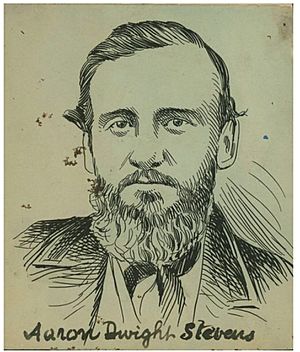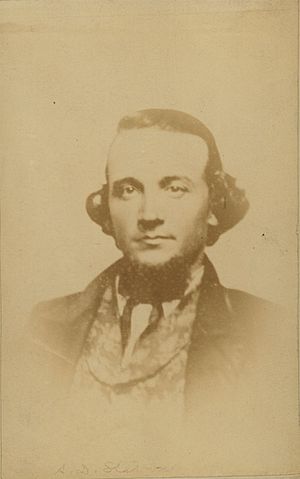Aaron Dwight Stevens facts for kids
Quick facts for kids
Aaron Dwight Stevens
|
|
|---|---|
 |
|
| Born | March 15, 1831 |
| Died | March 16, 1860 (aged 29) |
| Occupation | Chief military aide to John Brown |
| Known for | Abolitionist |
Aaron Dwight Stevens (born March 15, 1831 – died March 16, 1860) was an important American abolitionist. Abolitionists were people who wanted to end slavery. Stevens was the only one of John Brown's raiders who had military experience. He was the main military helper for John Brown during Brown's famous but failed attack on the federal arsenal in Harpers Ferry, West Virginia. Because of his role in this raid, Stevens was executed on March 16, 1860, when he was 29 years old.
Contents
Aaron Stevens' Early Life
Stevens was born in Lisbon, Connecticut, on March 15, 1831. His family later moved to Norwich, Connecticut, where his father led the choir at a church. When he was 16, in 1847, Stevens ran away from home.
He joined the army and fought in the Mexican–American War. Later, he joined another army unit called the First United States Dragoons. While serving, he faced serious charges for standing up to a major who was reportedly mistreating soldiers. Stevens and three others were sentenced to death, but their sentences were changed to three years in prison.
He escaped from prison at Fort Leavenworth. After escaping, he joined the "Free State" forces in Bleeding Kansas. This was a time when Kansas was fighting over whether it would be a free state or a slave state.
Joining John Brown
Stevens became a colonel in the 2nd Kansas Militia. He used the name Charles Whipple. He first met John Brown on August 7, 1856. This was when an army marched into "Bleeding Kansas." Stevens quickly became one of Brown's most loyal and brave followers.
While working with Brown in Kansas, Stevens was involved in a situation where he defended himself and others while trying to help an enslaved woman gain her freedom.
The Harpers Ferry Raid
In 1859, Stevens took part in John Brown's raid on Harpers Ferry, Virginia. This was a plan to start a slave revolt by taking over a federal weapons storehouse. According to another raider, Osborne Anderson, Stevens taught Brown's men military skills. He was the second-in-command for military actions, right after Captain Brown.
During the raid, Stevens, Brown, and other raiders were trapped inside the arsenal's engine house. Stevens wanted the raiders to escape, but Brown decided they should stay. Brown believed enslaved people would come to them for help. Brown sent Stevens and his son, Watson Brown, outside to talk under a flag of truce. However, Stevens was shot and captured by militia members. Even though he was badly hurt, he stayed awake and clear-headed. When asked if anyone was "dear to him," Stevens replied, "All those who are good are dear to me."
Trial and Execution
After his capture, Stevens was held in the same cell as John Brown. He was in a very bad physical state because of his wounds. He had four bullets in his body, two near his head and neck. Despite his pain, he stayed strong and didn't complain. People described him as a "splendid looking young fellow" with "black and penetrating eyes." He was considered Brown's best and most reliable soldier.
Stevens's father traveled from Connecticut to visit him in jail.
During his time in prison, Stevens never changed his mind that the Harpers Ferry raid was the right thing to do. In a letter to a friend from jail, he wrote that he felt no guilt. He believed he was trying to do good for the world. He hoped everything would turn out for the best. He also wrote about how sad he was for the thousands of enslaved people. He wished the country could be free and said he would give a thousand lives if he had them.
Stevens was tried in Charles Town, Virginia. He was found guilty of planning a revolt with enslaved people. He was executed by hanging on March 16, 1860. This was just one day after his 29th birthday. His last words to John Brown were, "Captain Brown, I'll see you in a better land."
After his death, Stevens's body was sent to New Jersey for a funeral. He was first buried at Eagleswood Cemetery. Later, in 1898, his body was moved. He was reburied next to John Brown's grave at the John Brown Farm State Historic Site in North Elba, New York.
See Also
- John Brown's raiders


